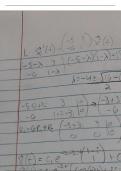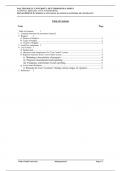Working group 1 05-09-2019
Question 1 (chapter 13, problem 2)
Equation (13-2) tells us that to reduce a current account deficit a country must increase
its private saving, reduce domestic investment, or cut its government budget deficit.
Nowadays, some people recommend restrictions on imports from China (and other
countries) to reduce the American current account deficit. How would higher U.S. barriers
to imports affect its private saving, domestic investment, and government deficit? Do you
agree that import restrictions would necessarily reduce a U.S. current account deficit?
Answer:
Equation 13-2: SP = I + CA - Sg = I + CA – (T – G) = I + CA + (G – T)
CA = Sp – I + (T – G)
if Sp goes up, I goes down and (T – G) goes up, CA goes up.
Investment:
Goes up: domestic people can’t import stuff, so they have to produce it
themselves in their own country.
Goes down: because import costs more money, firms invest less in their own
country, because they have to use their own money to import their products.
Could increase; imports restricted demand is not satisfied by imports
Local industries protected by the tariff increase investment, since demand for
locally produced goods increases. This might even worsen the CA (According to
the identity).
Could decrease; if intermediate goods, necessary for investment, are part of the
tariff, this will lead to an increase in the costs of investment. This might indeed
improve the CA (according to the identity).
Private savings:
Goes up: if the private savings goes up, the current account goes up.
If they reduce their usual consumption, the private saving could increase.
The tariff increases domestic prices. If consumers like to retain their present level
of consumption, they dissave. A higher share of their income is being consumed,
so private saving falls.
The CA might even worsen (according to the identity).
Goes down: because prices increase due to the restriction, so people have less
money to save if people want to keep their usual consumption (keep their
standard of living).
if the tariff is a temporary one, consumers expect a lower tariff, hence a lower
price, in the future; they save now and purchase the good in the future.
The CA might improve in the short run (according to the identity).
Government deficit:
Goes up: the tariff increases domestic prices. The government may not be able to
avoid expenditures on certain import goods (or expensive domestic substitutes).
The CA might even worsen (according to the identity).
Too little is known to provide a definite answer.
To predict how the CA is affected, we require a macroeconomic general
equilibrium analysis.
How to conceptualize the question?
Conceptualize means forming an opinion/getting an idea
Present the problem in an illuminating way
What is asked? What is given/what do we know?
What is asked?
, 1. Claim: equation (13-2) says S goes up, or I goes down, or (G – T) goes up CA
goes up
Exposed identity: this equation has to be true at the end of the period.
Claim is wrong: it is an identity, not a causal link. It is still true in the
end, but you can’t say if one goes up, the other goes up/down.
2. What is effect of import barriers on S or I or (T – G)?
Would they necessarily reduce CA?
Intermediate goods: imported goods that countries need in their own
production.
Not the answer itself, but the reasoning behind it makes the answer
correct.
What do we know?
CA = (Sp – I) + (T – G)
Question 2 (chapter 13, problem 3)
Explain how each of the following transactions generates two entries – a credit and a
debit – in the American balance of payments accounts and describe how each entry
would be classified.
b: An American buys a share of a German stock, paying the seller with a check
[drawn] on an American bank
a: An American buys a share of a German stock, paying by writing a check on an
account with a Swiss bank
d: A tourist from Detroit buys a meal at an expensive restaurant in Lyon, France,
paying with a traveler’s check
e: A California winemaker contributes a case of wine for a London wine tasting.
f: A US-owned factory in Britain uses local earnings to buy additional machinery.
Answer:
b: Asset purchases (importing an asset from Germany; debit, FA) and sale an asset
(‘export’ of an asset to Germany; credit, FA)
Asset exchange
a: Stock purchase: ‘import’ an asset from Germany; FA, money outflow, debit
Deposit sale: ‘export’ of an asset to Switzerland; FA, money outflow, credit
Asset exchange
There must be for instance a deposit purchase in Germany that is offset by a
deposit sale in Switzerland to rebalance the balances of Germany and Swizz.
d: Meal purchase: ‘import’ of a good from France; CA, money outflow, debit
Traveller check sale: ‘export’ of an asset; FA; money inflow; credit.
e: There is no money involved, so there are no market transactions.
Contribution: it is a gift, there is no money involved.
f: Local earning, has nothing to do with US. This involves an offshore transaction, no
international flow of money.
What do we know?
The residence of the individual or firm is what counts. In our US-centered
problems, the question is whether or not a US-resident is involved. Usually,
nationality and residence coincide.
It is about the flows of money
A good export will immediately have an asset import, you will have an asset in the foreign
country (asset purchase).
If you export a good, you will export an asset to the rest of the world (asset sale).
Question 1 (chapter 13, problem 2)
Equation (13-2) tells us that to reduce a current account deficit a country must increase
its private saving, reduce domestic investment, or cut its government budget deficit.
Nowadays, some people recommend restrictions on imports from China (and other
countries) to reduce the American current account deficit. How would higher U.S. barriers
to imports affect its private saving, domestic investment, and government deficit? Do you
agree that import restrictions would necessarily reduce a U.S. current account deficit?
Answer:
Equation 13-2: SP = I + CA - Sg = I + CA – (T – G) = I + CA + (G – T)
CA = Sp – I + (T – G)
if Sp goes up, I goes down and (T – G) goes up, CA goes up.
Investment:
Goes up: domestic people can’t import stuff, so they have to produce it
themselves in their own country.
Goes down: because import costs more money, firms invest less in their own
country, because they have to use their own money to import their products.
Could increase; imports restricted demand is not satisfied by imports
Local industries protected by the tariff increase investment, since demand for
locally produced goods increases. This might even worsen the CA (According to
the identity).
Could decrease; if intermediate goods, necessary for investment, are part of the
tariff, this will lead to an increase in the costs of investment. This might indeed
improve the CA (according to the identity).
Private savings:
Goes up: if the private savings goes up, the current account goes up.
If they reduce their usual consumption, the private saving could increase.
The tariff increases domestic prices. If consumers like to retain their present level
of consumption, they dissave. A higher share of their income is being consumed,
so private saving falls.
The CA might even worsen (according to the identity).
Goes down: because prices increase due to the restriction, so people have less
money to save if people want to keep their usual consumption (keep their
standard of living).
if the tariff is a temporary one, consumers expect a lower tariff, hence a lower
price, in the future; they save now and purchase the good in the future.
The CA might improve in the short run (according to the identity).
Government deficit:
Goes up: the tariff increases domestic prices. The government may not be able to
avoid expenditures on certain import goods (or expensive domestic substitutes).
The CA might even worsen (according to the identity).
Too little is known to provide a definite answer.
To predict how the CA is affected, we require a macroeconomic general
equilibrium analysis.
How to conceptualize the question?
Conceptualize means forming an opinion/getting an idea
Present the problem in an illuminating way
What is asked? What is given/what do we know?
What is asked?
, 1. Claim: equation (13-2) says S goes up, or I goes down, or (G – T) goes up CA
goes up
Exposed identity: this equation has to be true at the end of the period.
Claim is wrong: it is an identity, not a causal link. It is still true in the
end, but you can’t say if one goes up, the other goes up/down.
2. What is effect of import barriers on S or I or (T – G)?
Would they necessarily reduce CA?
Intermediate goods: imported goods that countries need in their own
production.
Not the answer itself, but the reasoning behind it makes the answer
correct.
What do we know?
CA = (Sp – I) + (T – G)
Question 2 (chapter 13, problem 3)
Explain how each of the following transactions generates two entries – a credit and a
debit – in the American balance of payments accounts and describe how each entry
would be classified.
b: An American buys a share of a German stock, paying the seller with a check
[drawn] on an American bank
a: An American buys a share of a German stock, paying by writing a check on an
account with a Swiss bank
d: A tourist from Detroit buys a meal at an expensive restaurant in Lyon, France,
paying with a traveler’s check
e: A California winemaker contributes a case of wine for a London wine tasting.
f: A US-owned factory in Britain uses local earnings to buy additional machinery.
Answer:
b: Asset purchases (importing an asset from Germany; debit, FA) and sale an asset
(‘export’ of an asset to Germany; credit, FA)
Asset exchange
a: Stock purchase: ‘import’ an asset from Germany; FA, money outflow, debit
Deposit sale: ‘export’ of an asset to Switzerland; FA, money outflow, credit
Asset exchange
There must be for instance a deposit purchase in Germany that is offset by a
deposit sale in Switzerland to rebalance the balances of Germany and Swizz.
d: Meal purchase: ‘import’ of a good from France; CA, money outflow, debit
Traveller check sale: ‘export’ of an asset; FA; money inflow; credit.
e: There is no money involved, so there are no market transactions.
Contribution: it is a gift, there is no money involved.
f: Local earning, has nothing to do with US. This involves an offshore transaction, no
international flow of money.
What do we know?
The residence of the individual or firm is what counts. In our US-centered
problems, the question is whether or not a US-resident is involved. Usually,
nationality and residence coincide.
It is about the flows of money
A good export will immediately have an asset import, you will have an asset in the foreign
country (asset purchase).
If you export a good, you will export an asset to the rest of the world (asset sale).











